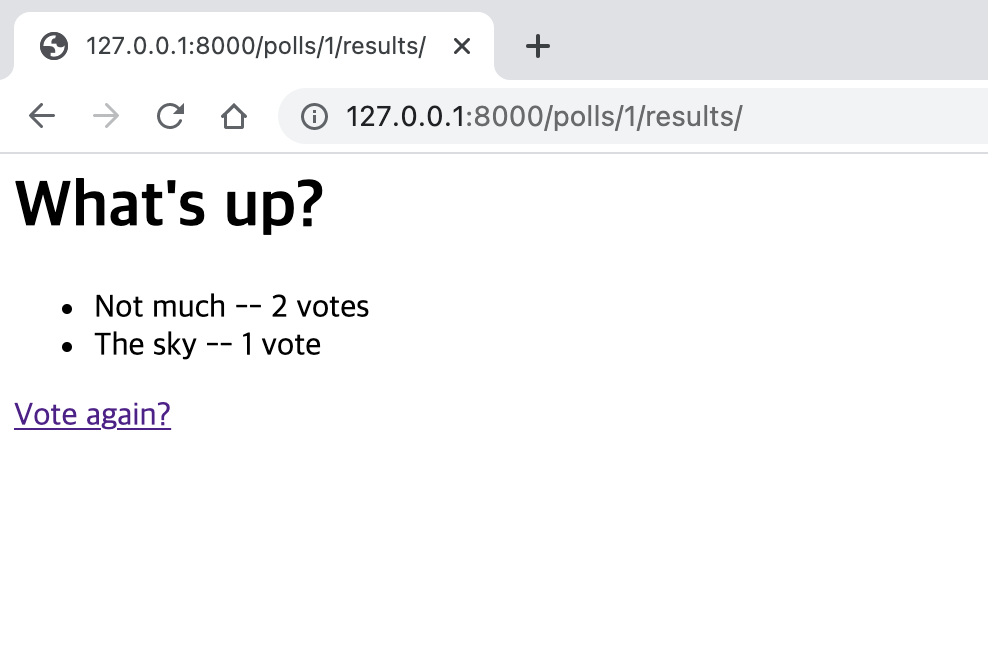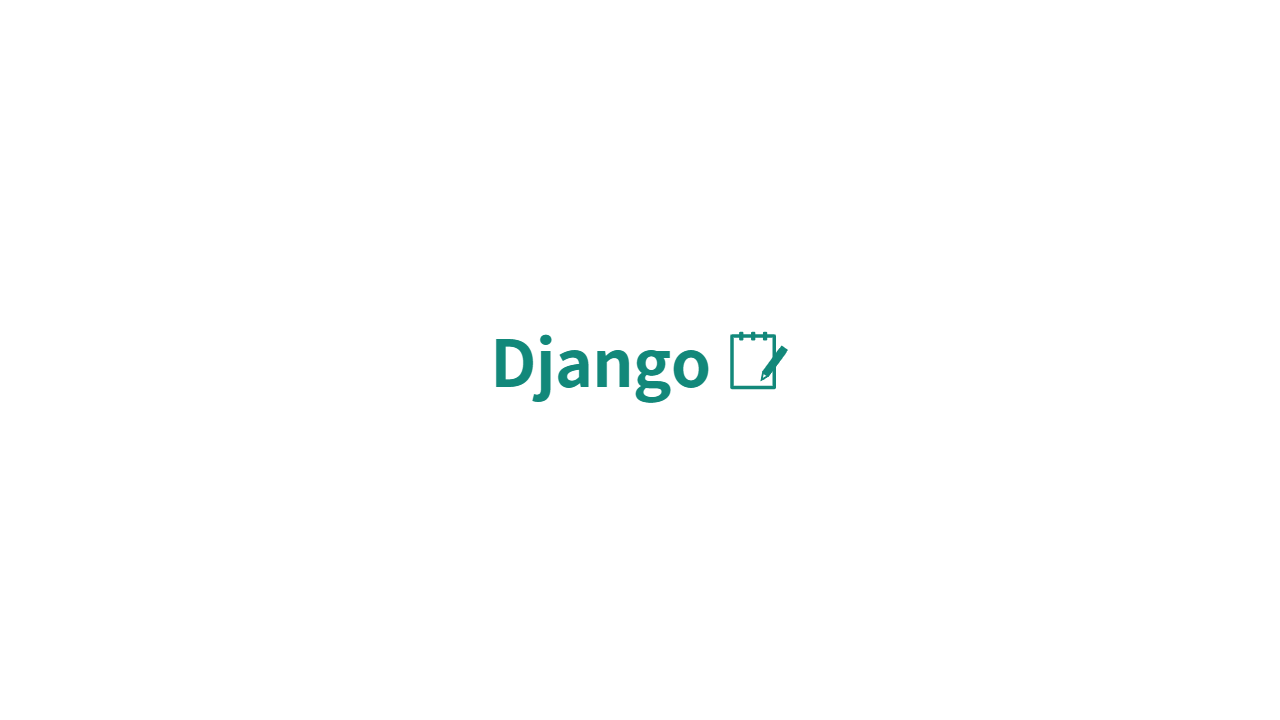view 추가하기
이제, polls/views.py 에 뷰를 추가해 봅시다. 이 뷰들은 인수를 받기 때문에 조금 모양이 다릅니다.
# polls/views.py
def detail(request, question_id):
return HttpResponse("You're looking at question %s." % question_id)
def results(request, question_id):
response = "You're looking at the results of question %s."
return HttpResponse(response % question_id)
def vote(request, question_id):
return HttpResponse("You're voting on question %s." % question_id)다음 path() 호출을 추가하여 이러한 새로운 뷰를 polls.urls 모듈로 연결하세요.
# polls/urls.py
from django.urls import path
from . import views
urlpatterns = [
# ex: /polls/
path('', views.index, name='index'),
# ex: /polls/5/
path('<int:question_id>/', views.detail, name='detail'),
# ex: /polls/5/results/
path('<int:question_id>/results/', views.results, name='results'),
# ex: /polls/5/vote/
path('<int:question_id>/vote/', views.vote, name='vote'),
]index함수 수정
# polls/views.py
from django.http import HttpResponse
from .models import Question
def index(request):
latest_question_list = Question.objects.order_by('-pub_date')[:5]
output = ', '.join([q.question_text for q in latest_question_list])
return HttpResponse(output)
# Leave the rest of the views (detail, results, vote) unchangedpolls 디렉토리에 templates 디렉토리 생성,
templates 디렉토리에 polls 디렉토리 생성,
templates/polls 에 index.html 파일 생성 후 코드 작성
<!--polls/templates/polls/index.html-->
{% if latest_question_list %}
<ul>
{% for question in latest_question_list %}
<li><a href="/polls/{{ question.id }}/">{{ question.question_text }}</a></li>
{% endfor %}
</ul>
{% else %}
<p>No polls are available.</p>
{% endif %}
템플릿을 이용하여 polls/views.py에 index 뷰 업데이트
# polls/views.py
from django.http import HttpResponse
from django.template import loader
from .models import Question
def index(request):
latest_question_list = Question.objects.order_by('-pub_date')[:5]
template = loader.get_template('polls/index.html')
context = {
'latest_question_list': latest_question_list,
}
return HttpResponse(template.render(context, request)) 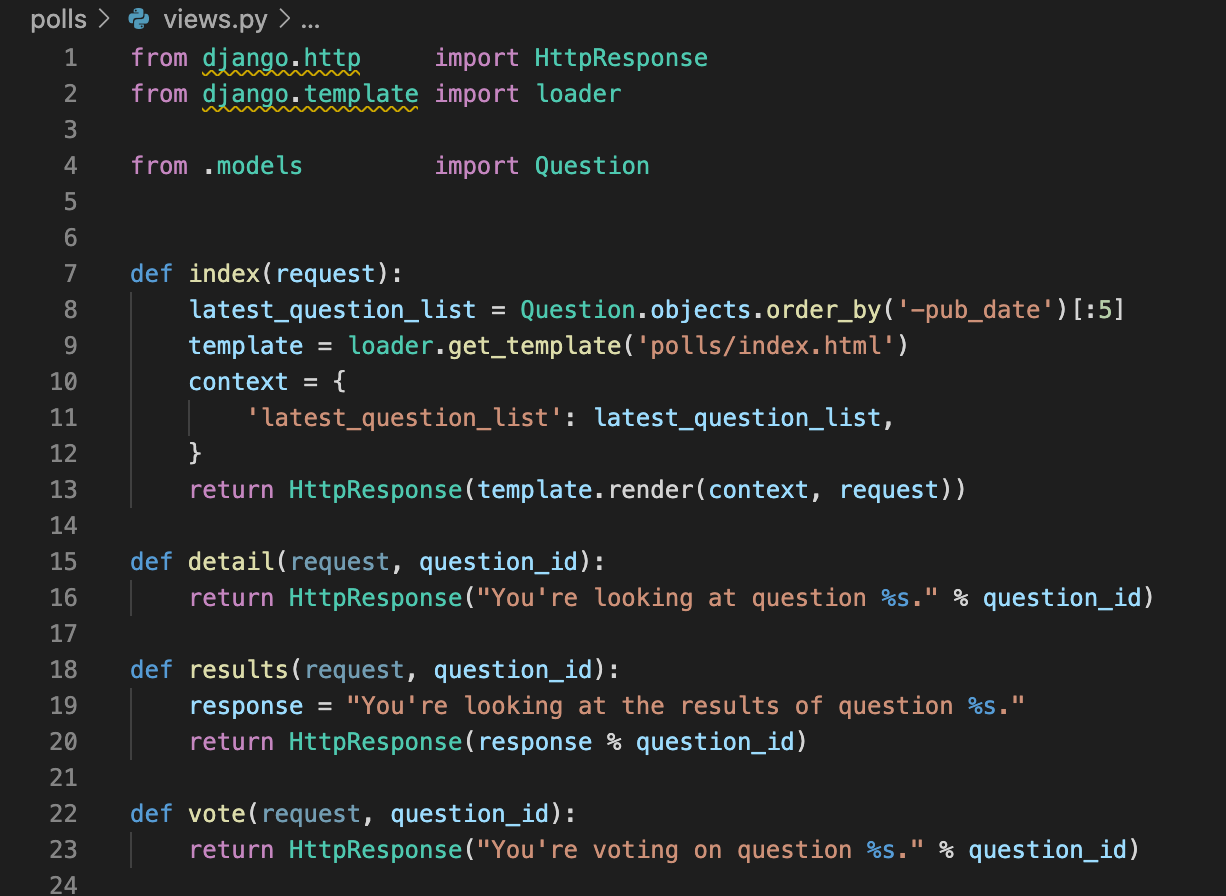
이 코드는 polls/index.html 템플릿을 불러온 후, context를 전달합니다. context는 템플릿에서 쓰이는 변수명과 Python 객체를 연결하는 딕셔너리 값입니다.
단축 기능 render()
index() 뷰를 단축 기능으로 작성하면 다음과 같습니다.
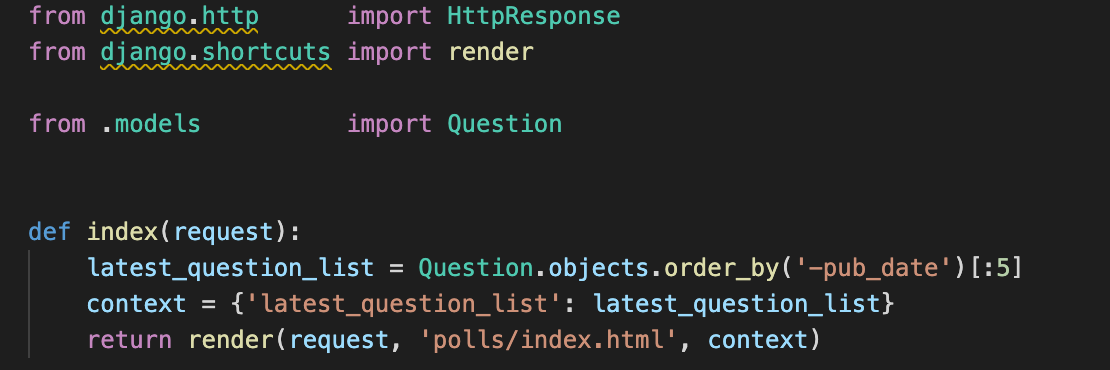
모든 뷰에 적용한다면, 더 이상 loader와 HttpResponse를 임포트하지 않아도 됩니다. (만약 detail, results, vote에서 stub 메소드를 가지고 있다면, HttpResponse를 유지해야 할 것입니다.)
404 에러 일으키기
# polls/views.py
from django.http import Http404
from django.shortcuts import render
from .models import Question
# ...
def detail(request, question_id):
try:
question = Question.objects.get(pk=question_id)
except Question.DoesNotExist:
raise Http404("Question does not exist")
return render(request, 'polls/detail.html', {'question': question})
뷰는 요청된 Question ID 가 없을 경우 Http404 예외를 발생시킵니다.
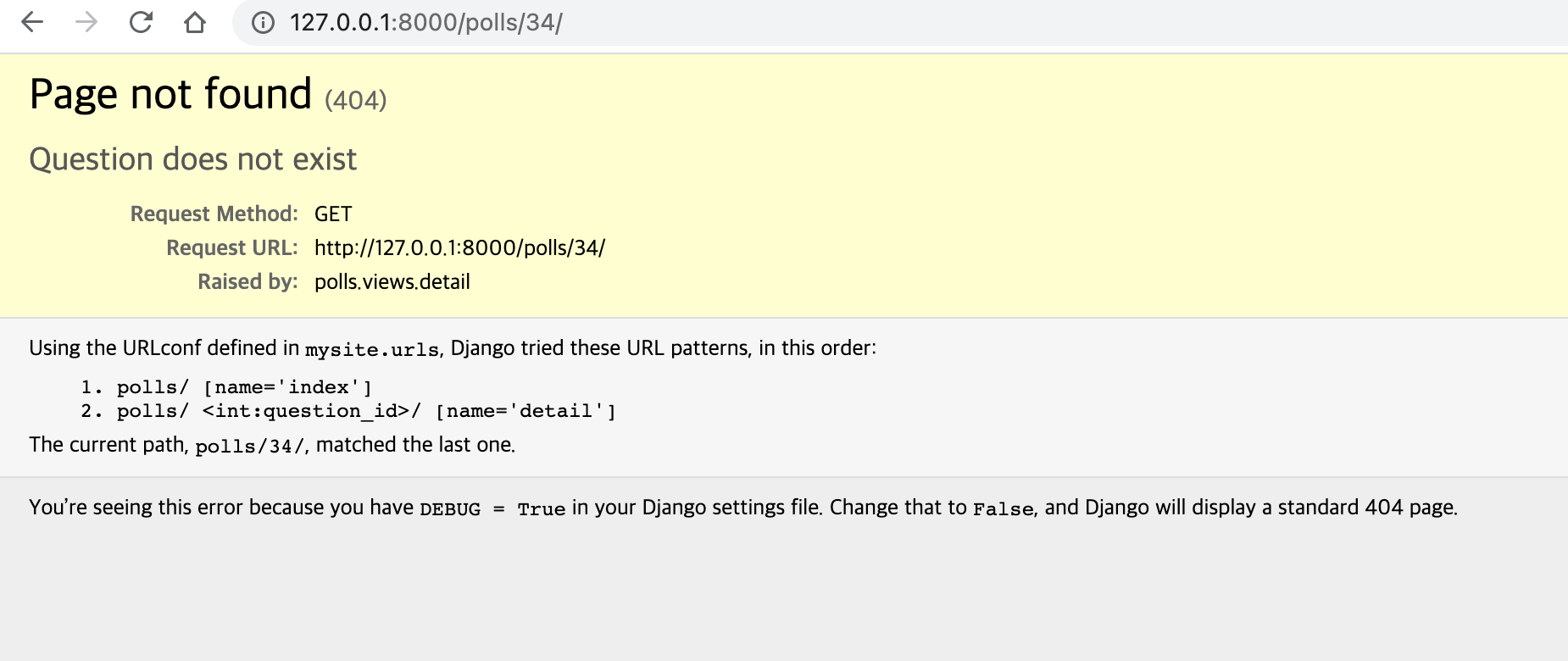
polls/templates/polls 에 detail.html 추가
<!--polls/templates/polls/detail.html-->
{{ question }}get_object_or_404,
객체가 존재하지 않을 때 get() 을 사용하여 Http404 예외를 발생
# polls/views.py
from django.shortcuts import get_object_or_404, render
from .models import Question
# ...
def detail(request, question_id):
question = get_object_or_404(Question, pk=question_id)
return render(request, 'polls/detail.html', {'question': question})
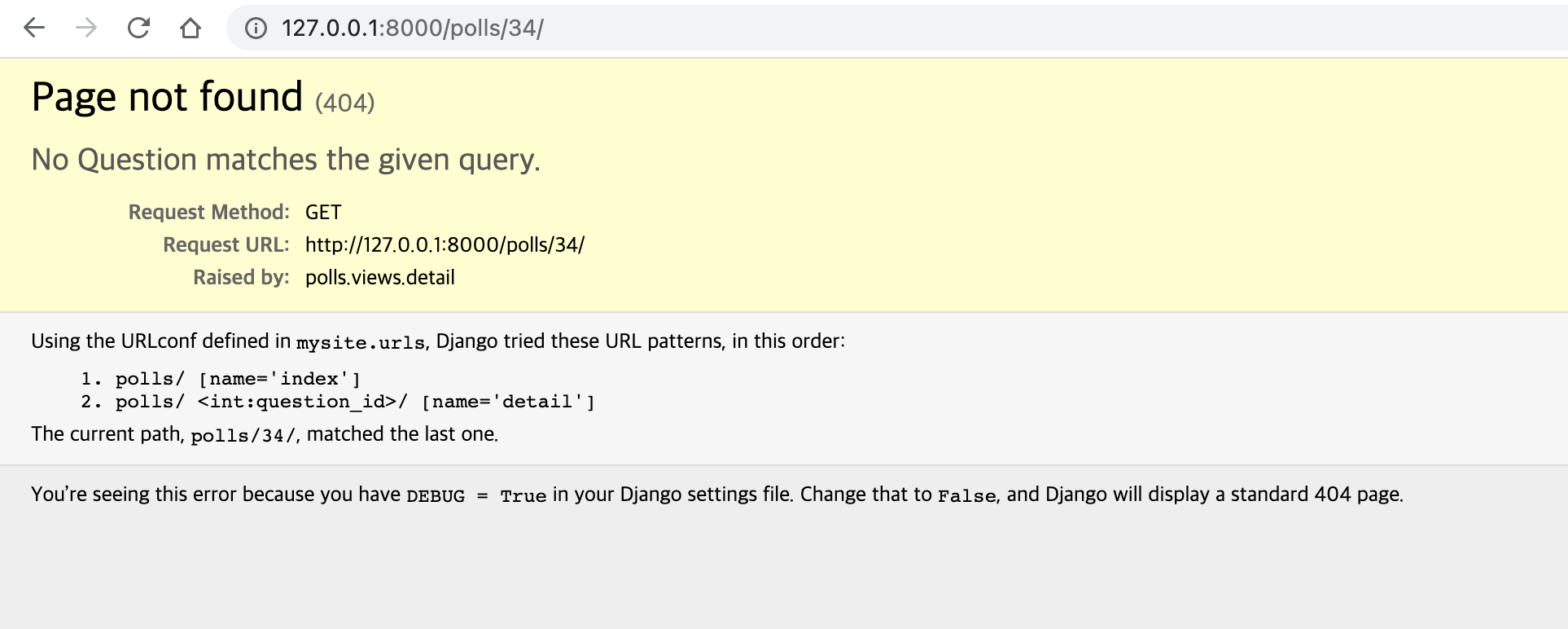
템플릿 시스템 사용하기
<!-- polls/templates/polls/detail.html -->
<h1>{{ question.question_text }}</h1>
<ul>
{% for choice in question.choice_set.all %}
<li>{{ choice.choice_text }}</li>
{% endfor %}
</ul>템플릿에서 하드코딩된 URL 제거하기
(index.html 수정)

튜토리얼의 프로젝트는 polls라는 앱 하나만 가지고 진행했습니다. 실제 Django 프로젝트는 앱이 몇개라도 올 수 있습니다. Django는 이 앱들의 URL을 어떻게 구별해 낼까요? 예를 들어, polls 앱은 detail이라는 뷰를 가지고 있고, 동일한 프로젝트에 블로그를 위한 앱이 있을 수도 있습니다. Django가 {% url %} 템플릿태그를 사용할 때, 어떤 앱의 뷰에서 URL을 생성할지 알 수 있을까요?
정답은 URLconf에 이름공간(namespace)을 추가하는 것입니다. polls/urls.py 파일에 app_name을 추가하여 어플리케이션의 이름공간을 설정할 수 있습니다.
# polls/urls.py
from django.urls import path
from . import views
app_name = 'polls'
urlpatterns = [
path('', views.index, name='index'),
path('<int:question_id>/', views.detail, name='detail'),
path('<int:question_id>/results/', views.results, name='results'),
path('<int:question_id>/vote/', views.vote, name='vote'),
]polls/index.html 변경
<!--polls/templates/polls/index.html-->
<li><a href="{% url 'polls:detail' question.id %}">{{ question.question_text }}</a></li>
Write a minimal form
앞장의 투표 상세 템플릿(《polls/detail.html》)을 수정하여, 템플릿에 HTML <form> 요소를 포함시켜 봅시다.
<!--polls/templates/polls/detail.html-->
<h1>{{ question.question_text }}</h1>
{% if error_message %}<p><strong>{{ error_message }}</strong></p>{% endif %}
<form action="{% url 'polls:vote' question.id %}" method="post">
{% csrf_token %}
{% for choice in question.choice_set.all %}
<input type="radio" name="choice" id="choice{{ forloop.counter }}" value="{{ choice.id }}">
<label for="choice{{ forloop.counter }}">{{ choice.choice_text }}</label><br>
{% endfor %}
<input type="submit" value="Vote">
</form>우리는 vote() 함수를 가상으로 만들었습니다. 실제로 구현을 해봅시다. polls/views.py 에 다음을 추가
from django.http import HttpResponse, HttpResponseRedirect
from django.shortcuts import get_object_or_404, render
from django.urls import reverse
from .models import Choice, Question
# ...
def vote(request, question_id):
question = get_object_or_404(Question, pk=question_id)
try:
selected_choice = question.choice_set.get(pk=request.POST['choice'])
except (KeyError, Choice.DoesNotExist):
# Redisplay the question voting form.
return render(request, 'polls/detail.html', {
'question': question,
'error_message': "You didn't select a choice.",
})
else:
selected_choice.votes += 1
selected_choice.save()
# Always return an HttpResponseRedirect after successfully dealing
# with POST data. This prevents data from being posted twice if a
# user hits the Back button.
return HttpResponseRedirect(reverse('polls:results', args=(question.id,)))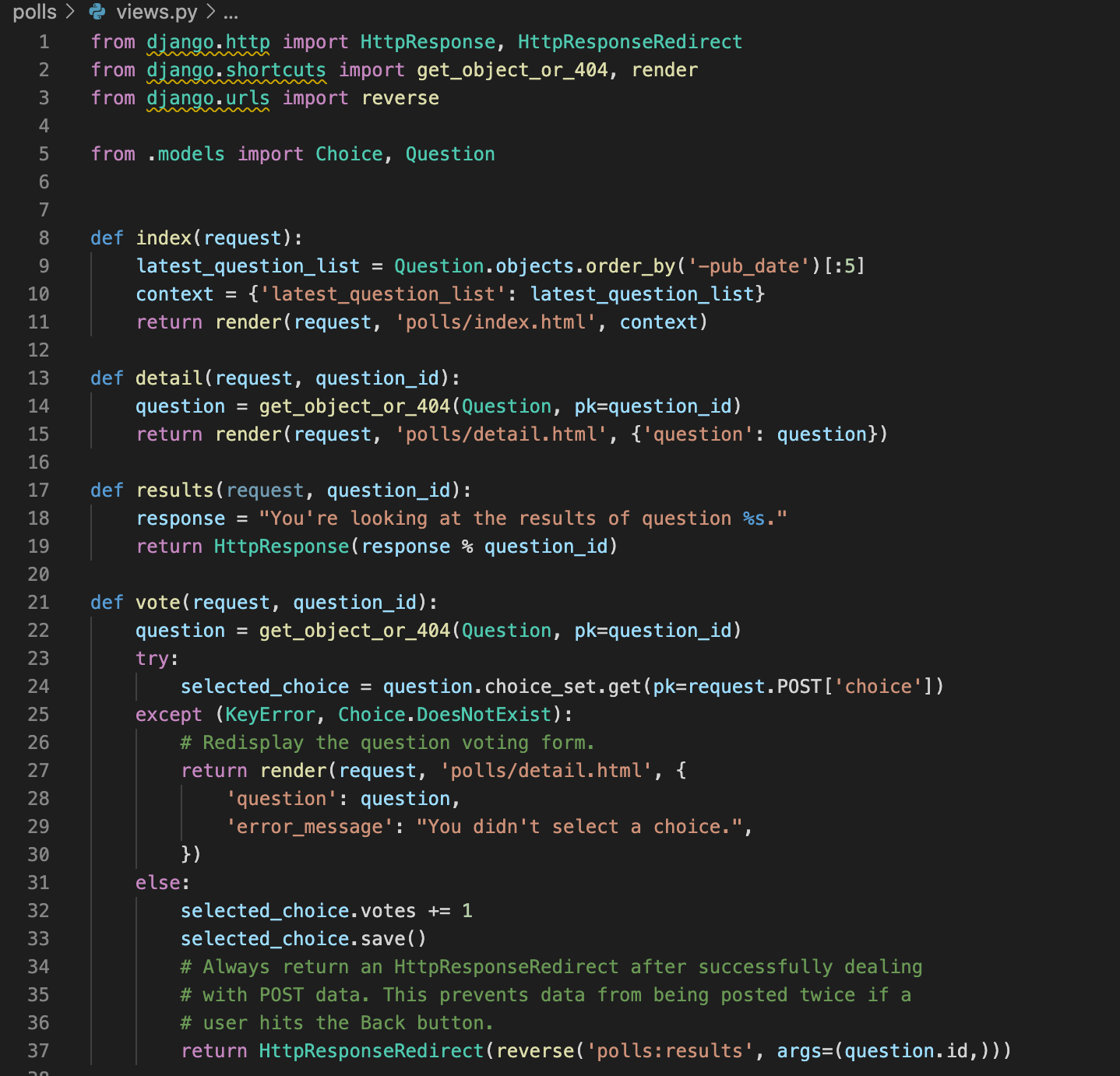
어떤 이가 설문조사에 설문을 하고난 뒤에는, vote() 뷰는 설문조사 결과 페이지로 리다이렉트합니다. 그 뷰를 작성해봅시다:
# polls/views.py
from django.shortcuts import get_object_or_404, render
def results(request, question_id):
question = get_object_or_404(Question, pk=question_id)
return render(request, 'polls/results.html', {'question': question})이제, polls/results.html 템플릿을 만듭니다.
<!--polls/templates/polls/results.html-->
<h1>{{ question.question_text }}</h1>
<ul>
{% for choice in question.choice_set.all %}
<li>{{ choice.choice_text }} -- {{ choice.votes }} vote{{ choice.votes|pluralize }}</li>
{% endfor %}
</ul>
<a href="{% url 'polls:detail' question.id %}">Vote again?</a>이제, 웹 브라우저에서 /polls/1/ 페이지로 가서, 투표를 해보세요. 당신이 투표를 할 때마다 값이 반영된 결과 페이지를 볼 수 있을 것입니다. 만약 당신이 설문지를 선택하지 않고 폼을 전송했다면, 오류 메시지를 보게 될 것입니다.
